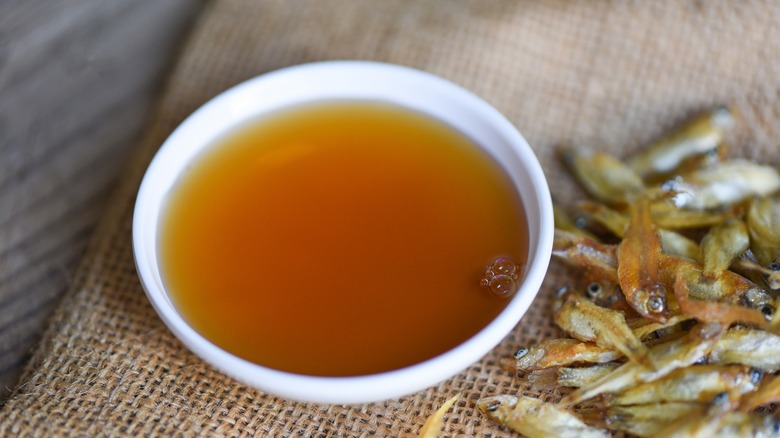Fish Sauce Is The Secret To Irresistibly Savory Fried Rice
We may receive a commission on purchases made from links.
Fish sauce is a cornerstone of many Asian cuisines. Admittedly, the pungent smell that wafts from the bottle the first time you crack one open may leave you second-guessing whether to put it into your food but trust us when we say that the taste is worth the intense scent. When added to dishes like fried rice, a dash of fish sauce can bring to the table an unparalleled depth of flavor that you can't replicate with salt or even soy sauce.
Fish sauce works so well in this recipe because fried rice is packed with one particular flavor: umami. Umami is that rich, savory, almost "meaty" flavor that makes your mouth water when you savor dishes like gravies or pork. This peculiar taste, separate from saltiness, can come from a number of sources in a platter of fried rice, from soy sauce to certain proteins such as sliced bacon and even Lap Cheong, a type of Chinese sausage. However, because fish sauce itself is also full of umami flavor — it is made from fermented fish — adding a dash of this into the recipe will amplify the lovely flavor and make for a much moreish meal.
First thing first, pick a good bottle of fish sauce
Before you bring out the wok and get to frying, you need to have a quality bottle of fish sauce first. This can be a bit tricky, especially if you've never had fish sauce before. Apart from sticking to well-known brands with good provenances like Red Boat or Three Crabs, you should pay close attention to the sauce's color.
Good fish sauce typically has a clear, amber color, similar to black tea. This color indicates that it's a first-press fish sauce, made from the initial extraction of the fermenting barrel. First-press fish sauces are prized for their exceptional flavor and balance, outshining later presses that can taste more diluted and may even contain added flavorings, which can make the sauce taste so pungent your tongue would tingle from the savoriness.
Once you've brought your chosen bottle home, resist the temptation to take a whiff; that is if the plume of fishy smell coming out of the bottle hasn't discouraged you yet. It's best not to taste the sauce itself either. Instead, start by adding a small amount to your cooking. Once it blends into your dish, fish sauce takes on a totally new (and absolutely delicious) flavor and aroma — a lot more appetizing this time around!
Take it slow the first time you add fish sauce into your Chinese fried rice
Once you have heated up your wok and given the steamed rice a quick stir-fry, add the fish sauce, along with other seasonings like soy sauce and sesame oil, into the pan. If it's your first time cooking with fish sauce, start slow. Fried rice already has plenty of saltiness and umami, as mentioned earlier. As such, it's easy to throw off this balance and end up with overly salty rice if you pour in too much fish sauce all at once. The same caution applies to recipes with a strong seafood flavor, like pineapple shrimp fried rice. If you choose to add fish sauce, it's best to use it very sparingly to avoid an overpowering fish taste. For most people, using about half a tablespoon of fish sauce should hit the sweet spot. It'll strike a nice, flavorful balance without overpowering your fried rice.
After working the seasonings into the rice and frying it for a bit, give it a taste! If you want it to be a bit more savory, you can add a quarter tablespoon at a time until the flavor's just right. You can continue to cook the rice for a few minutes until they're toasty, then take them off the heat. Season to your heart's content with salt and pepper (or a drizzle of Sriracha) and ring the dinner bell!


